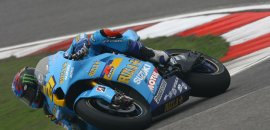From Trackpedia
Causes
Brake failure will result due to one of three things:
1. Brake fade: Caused because the pads grow too hot due to a partial and constant braking pressure.
2. Moist brakes: The brakes grow wet after passing through watersplashes or after Aquaplaning.
3. Hydraulic brake failure: The brakes fail due to damaged brake lines or empty cylinders. The pedal should lose pressure and might even "fark".
Solution
Besides the hydraulic footbrake, a car can be slowed down by other means:
- Hydraulic brake: The footbrake rarely fails completly. The driver should deal with it lightly to make the most out of whatever braking force it still has. If the brakes heat-up, the driver needs to use them as little as possible, applying them a bit and releasing (but not pumping). And using the other options to slow down the car. Once it stopped, release the footbrake. If the brakes are wet, brake moderatly for a few moments, release and reapply for two-three times (don't pump!). This should dry the brakes out. If the brakes fails due to hydraulic causes pump them rapidly a few times (without letting go completly) to pump the mass-cylinder. Now, squizze it down to the floor. If it takes too long, release for a few moments, and reapply.
- Compression brake: Use engine braking to slow down the car: Downshift sequentally (without heel and toe), and use Ritarders, exhaust brake and J-Brake if available. Try to avoid locking the driving wheels by applying these means too hard.
- Mechnical brake: The E-brake. Press the ratchet button in and lift it up slightly and smoothly to help slow down the car, and apply more of it to bring the car to a final halt, once speed has been decreased.
- Friction: Use friction to slow down the car:
- Open windows to allow drag to slow down the car. This also has the advantage of allowing to alert others. However, most racing cars don't enable this.
- Use "swaying" manouver, turning the wheel from side to side to create drag.
- As a last resort, use rails and the gravel on the edge of the track to slow you down.
Once the car stopped, station it with the E-brake and ease off of the footbrake. If you stay on the footbrake while your brakes are hot, it can "wrap" them (a concept often confused with wheel-lockup).
Avoidance
If you use correct Threshold braking you will brake for a shorter duration of time, allowing to avoid heating the brakes. Checking the brake pads, fluids and lines before the race should make hydraulic brake failure very unlikely. Keep in mind that it's better to keep a constant and slight brake pressure, than to pump the brakes, and that it is better to brake hard (threshold braking) and for a short distance than brake moderatly and over a greater distance. Also, unless the brakes have failed, don't use engine braking, unless driving on a constant downhill. If you need to brake, apply the brakes lightly for a few seconds, release for a moment, and reapply, do not pump.
External links
http://www.driftingstreet.com/braking-technique-left-foot.html
